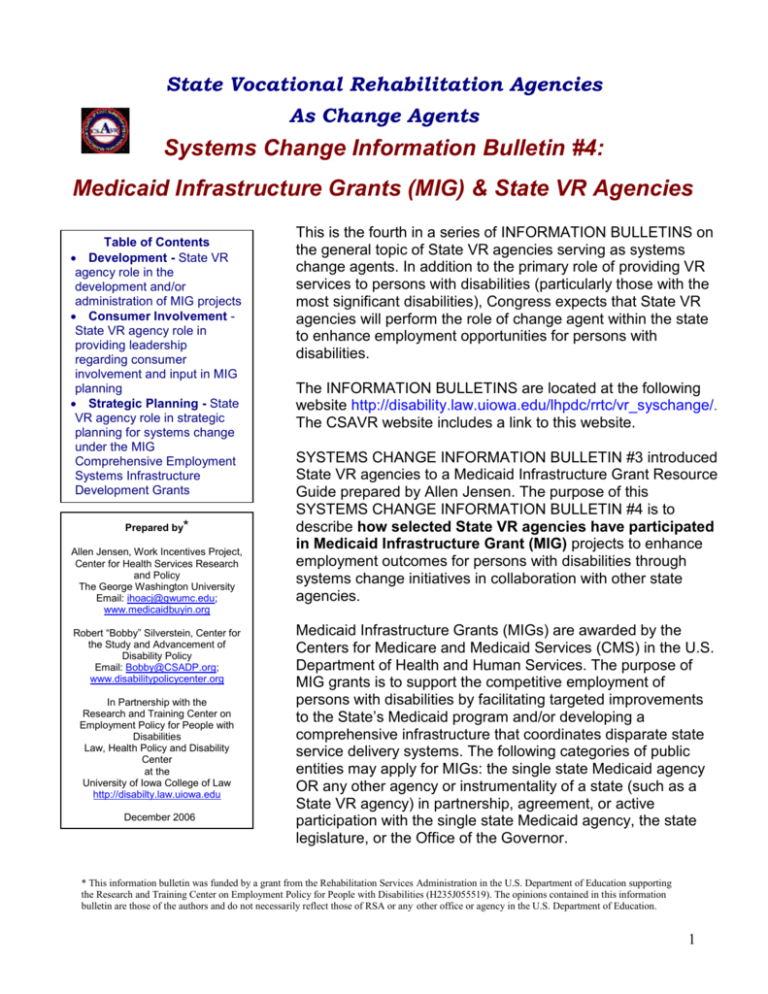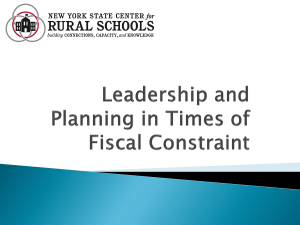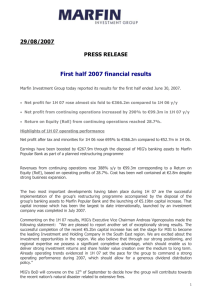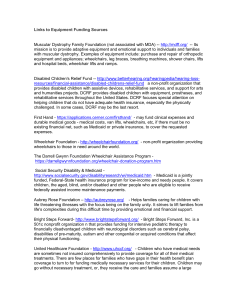State Vocational Rehabilitation Agencies
advertisement

State Vocational Rehabilitation Agencies As Change Agents Systems Change Information Bulletin #4: Medicaid Infrastructure Grants (MIG) & State VR Agencies Table of Contents Development - State VR agency role in the development and/or administration of MIG projects Consumer Involvement State VR agency role in providing leadership regarding consumer involvement and input in MIG planning Strategic Planning - State VR agency role in strategic planning for systems change under the MIG Comprehensive Employment Systems Infrastructure Development Grants Prepared by* Allen Jensen, Work Incentives Project, Center for Health Services Research and Policy The George Washington University Email: ihoacj@gwumc.edu; www.medicaidbuyin.org Robert “Bobby” Silverstein, Center for the Study and Advancement of Disability Policy Email: Bobby@CSADP.org; www.disabilitypolicycenter.org In Partnership with the Research and Training Center on Employment Policy for People with Disabilities Law, Health Policy and Disability Center at the University of Iowa College of Law http://disabilty.law.uiowa.edu December 2006 This is the fourth in a series of INFORMATION BULLETINS on the general topic of State VR agencies serving as systems change agents. In addition to the primary role of providing VR services to persons with disabilities (particularly those with the most significant disabilities), Congress expects that State VR agencies will perform the role of change agent within the state to enhance employment opportunities for persons with disabilities. The INFORMATION BULLETINS are located at the following website http://disability.law.uiowa.edu/lhpdc/rrtc/vr_syschange/. The CSAVR website includes a link to this website. SYSTEMS CHANGE INFORMATION BULLETIN #3 introduced State VR agencies to a Medicaid Infrastructure Grant Resource Guide prepared by Allen Jensen. The purpose of this SYSTEMS CHANGE INFORMATION BULLETIN #4 is to describe how selected State VR agencies have participated in Medicaid Infrastructure Grant (MIG) projects to enhance employment outcomes for persons with disabilities through systems change initiatives in collaboration with other state agencies. Medicaid Infrastructure Grants (MIGs) are awarded by the Centers for Medicare and Medicaid Services (CMS) in the U.S. Department of Health and Human Services. The purpose of MIG grants is to support the competitive employment of persons with disabilities by facilitating targeted improvements to the State’s Medicaid program and/or developing a comprehensive infrastructure that coordinates disparate state service delivery systems. The following categories of public entities may apply for MIGs: the single state Medicaid agency OR any other agency or instrumentality of a state (such as a State VR agency) in partnership, agreement, or active participation with the single state Medicaid agency, the state legislature, or the Office of the Governor. * This information bulletin was funded by a grant from the Rehabilitation Services Administration in the U.S. Department of Education supporting the Research and Training Center on Employment Policy for People with Disabilities (H235J055519). The opinions contained in this information bulletin are those of the authors and do not necessarily reflect those of RSA or any other office or agency in the U.S. Department of Education. 1 The Medicaid Infrastructure Grant program is authorized and funds are appropriated for fiscal year 2006 through fiscal year 2011. A total of $41.779 million was allocated among the states for fiscal year 2006. The minimum award for a state is $500,000 and, if a state qualifies under a Comprehensive Employment Systems MIG grant project, a state can request an amount up to ten percent of the Medicaid Buy-In program expenditures in the state, including both federal and state dollars. For example, Connecticut received an award of $5.1 million for calendar year 2007. The official government website for MIGs is http://www.cms.hhs.gov/TWWIA/03_MIG.asp . For a comprehensive website describing the specific projects and activities conducted by all MIG grantees organized by topic area, see www.medicaidbuyin.org. Additional websites related to MIG grants include the MIG Technical Assistance Center at the National Center for Health Systems Development (NCHSD) at http://www.nchsd.org/ and the MIG Technical Assistance Center at the American Public Human Services Association (APHSA) Center for Workers with Disabilities (CWD) http://www.aphsa.org/disabilities/home/index.htm. As described in this Information Bulletin, there are a wide variety of roles that State Vocational Rehabilitation agencies can play in designing, implementing, and evaluating MIG projects, including locating the MIG grant in the State VR agency. State VR agencies that have assumed leadership roles or are active participants in MIG projects report that the partnerships which they have developed with other state agencies, particularly the Medicaid agency and other agencies providing health related services and supports, are leading to improved employment outcomes for VR clients and other persons with disabilities seeking increased work and earnings. On a more operational level, participation in MIG projects is serving as an additional source of funding to State VR agencies for critical programs, projects and activities. Specifically, this INFORMATION BULLETIN includes a discussion of the following roles played by State VR agencies: State VR agency role in the development and/or administration of MIG projects State VR agency role in providing leadership regarding consumer involvement and input in MIG planning State VR agency role in strategic planning for systems change under the MIG Comprehensive Employment Systems Infrastructure Development Grants State VR Agency Role in the Development and/or Administration of MIG Projects In Vermont, Oregon, Utah and Connecticut, the State VR agency administers/houses the MIG project and was the agency primarily responsible for the development of the original MIG proposal. This arrangement provides an incredible opportunity for these VR agencies to influence/affect policies, practices, and procedures within the Medicaid agency regarding the provision of health-related services and supports that enhance employment of persons with disabilities. In Virginia, the State VR agency worked together with the State Medicaid agency to develop the initial MIG proposal and now jointly administers the MIG project which included the 2 development of a Medicaid Buy-In program enacted in 2006. Prior to working together on the MIG proposal, the State VR agency worked jointly with the state Medicaid agency to improve utilization of Section 1619 SSI/Medicaid work incentives. The State VR agency is promoting two consumer focused projects. One is the Working Knowledge Project, which is targeted to individuals with serious mental illness and provides supports and information needed to obtain or retain employment. This is intended as a preparation for their participation in the Medicaid Buy-In program. Another initiative is the training of Work Incentive Specialist Advocates to provide services which will result in VR clients who are eligible using SSA Work Incentives. This will be a vended service designed to increase the use of Work Incentives in preparation of eligible participants electing to enroll in the Medicaid Buy-In program. In New Mexico the State VR agency drafted the original MIG proposal for the State Medicaid agency to submit to CMS and continues through a subcontract with the state Medicaid agency’s MIG project to coordinate the SSA-funded Work Incentives Planning and Assistance projects (WIPA), similar programs funded by the MIG project to provide outreach and benefits planning related to the state Medicaid Buy-In program, and the Department of Labor/Social Security Administration Disability Navigator program. In Indiana, the State VR agency, prior to the availability of MIG project funds, funded a special project at Indiana University’s Center on Community Living and Careers to work with a coalition of disability advocates to develop a Medicaid Buy-In proposal. Subsequently that VR-funded effort assisted the state Medicaid agency to develop a MIG proposal. The MIG project now funds a joint effort of the state VR agency and the Center at Indiana University which has established a Benefits Information Network to assist in the benefits planning for SSI and SSDI beneficiaries. State VR Agency Leadership in Ensuring Consumer Involvement and Input In MIG Planning In Michigan, the State VR agency staff played a major role in bringing the MIG grant to the state. In collaboration with the Michigan Department of Community Health, the state received its first MIG grant in 2005. VR staff meets regularly with a coalition of disability advocacy organizations (MIJob Coalition - 35 statewide advocacy organizations). When the Coalition advocated for the state to apply for a MIG project, VR staff and the Coalition teamed with state officials to design and write the original MIG proposal submitted to CMS. The State VR agency continues to be a member of the MIG Advisory Group. In Virginia the State VR agency plays a complementary role to the State Medicaid agency in ensuring that consumers and disability advocates are actively involved in setting priorities and are involved in the MIG advisory committee’s various task forces. Those MIG Task Forces in Virginia, with a primary role in staffing the Task Forces by State VR, include: Communication and Education; Technical Design of Medicaid Buy-In; and Coordination of Services. 3 State VR Agency Role in Strategic Planning for Systems Change Under the MIG Comprehensive Employment Systems Infrastructure Development Grants New and more comprehensive systems change roles are now being assumed by a number of state MIG projects and have significant implications regarding the potential role of State VR agencies in MIG projects. Beginning in 2005, states have had the opportunity, if they meet criteria related to a Medicaid Buy-In and Personal Assistance Services (PAS), to apply for a “Comprehensive Employment Systems Infrastructure Development” MIG grant.1 In the initial year these grants are to be devoted to the development of multi-agency strategic plans to improve employment of persons with disabilities. Of the thirteen states2 with MIG Comprehensive Employment Systems Infrastructure Development grants, in four states (Connecticut, Oregon, Utah, and Vermont), the State VR agency administers/houses these MIG comprehensive development projects.3 In these four states, the strategic planning process involves multiple agencies, consumers and disability advocates and the business community. The Strategic Plans developed under the leadership of the state VR agency resulted in proposals for systems change which included but are not limited to programs and services administered by the State VR agency. Examples of systems change priorities that emerged from the MIG Strategic Planning process led by the State VR agencies include: Developing a benefits planning and work incentives system which is integrated into multiple agencies employment services system and which is sustainable. Developing a youth transition support system involving multiple agencies which improves employment outcomes for youth transitioning from school. Changing the workforce systems to connect job seekers with disabilities with employers in the state. Changing cultural attitudes and expectations by persons with disabilities, providers and employers related to employment Creating and enabling peer mentoring and supports by persons with disabilities as a means to increase employment More specifically, set out below are additional details on each of the four state’s priority issue areas and, where available, links to the Strategic Plans that have been developed. In addition, set out below is an overview of the key role the California VR agency is playing in implementing the state MIG. The California Department of Rehabilitation (DOR) is an active member of the California’s MIG, the Health Incentives Improvement Project (CHIIP), which is a multi-agency 1 See Systems Change Information Bulletin # 3 for details regarding these Comprehensive Employment Systems Infrastructure Development” MIG grants. 2 Comprehensive MIG Projects are in: Alaska, California, Connecticut, Maine, Massachusetts, Minnesota, New Mexico (2005 –only), North Dakota, Oregon, Utah, Vermont, Washington (2005-only), West Virginia and Wisconsin. See description of projects and links to State MIG CEO Strategic Plans at www.medicaidbuyin.org 3 In five of the other nine states, the MIG Comprehensive Employment Project is housed at a University under a contract with the state Medicaid agency. Those states are: California, Maine, Massachusetts, North Dakota, and West Virginia. 4 collaborative effort working to remove barriers to employment and self-sufficiency of people with disabilities, particularly health care and personal assistance barriers. DOR staff attends quarterly board meetings assisting with: Developing demonstration projects designed to increase statewide planning for services for youth with disabilities. Building state and local intergovernmental infrastructures to remove healthcare and other barriers to employment for people with disabilities. Increasing the number of participants utilizing the Medi-Cal Working Disabled and InHome Supportive Services in the Workplace programs through outreach to people with disabilities, service providers, eligibility workers and employers. Strengthening labor force connections for people with disabilities by expanding and supporting the disability benefits counseling and training infrastructure of state and local program administrators, front line staff and community-based organizations who assist people with disabilities in achieving successful employment outcomes and economic self-sufficiency. Website: www.chiip.org Contact: Michelle Alford-Williams malfordw@dor.ca.gov In Connecticut, which began its MIG Comprehensive infrastructure development effort in 2006, the State VR agency is leading an effort to enhance collaboration among twelve state agencies, including the Medicaid agency, with the goal of improving employment outcomes for persons with disabilities. The Connecticut Bureau of Rehabilitation Services administers the state’s $5.1 million MIG grant (calendar year 2007). MIG grant funds were used to hire 7 additional VR staff, including a project director, 2 policy analysts, 2 service specialists, and 2 FTE benefit counselors. The amount the state receives, in excess of the $500,000 state minimum, is related to the fact that, as of June 30, 2006, the state has 4,101 individuals enrolled in their Medicaid Buy-In program. The MIG grant enabled The Connecticut Bureau of Rehabilitation Services to engage in a reorganization effort to support systems change designed to embed employment as a legitimate outcome in various state initiatives. The Bureau now includes a Connect to Work Center that is responsible for administering, among other things, the MIG projects, Work Incentive Planning and Assistance (WIPA) grants, Nursing Facilities Transition grants, Medicaid Buy-In programs, Assistive technology, personal assistance services, independent living programs, community bridging for adults and young adults with disabilities, and the Ticket to Work program. In addition, the state Medicaid agency delegated to the VR agency lead agency designation in a recently submitted proposal under the Money Follows the Person federal grant initiative. For more information regarding the Connect to Work Program, contact Amy Porter, the project director at amy.porter@ct.gov. The link to the website is http://www.brs.state.ct.us/StrategicEmployment.htm The $5.1 million MIG funds will be divided, with half going to statewide technical assistance and infrastructure needs, and the other half going to local level initiatives. Local level activities will be led by businesses in each of the communities, and will serve to advance the first four goals of the strategic plan. These goals are as follows: 5 Goal 1: To improve the transition process for young adults moving from school to postsecondary education or employment. Goal 2: To increase expectations for people with disabilities in achieving career potential. Goal 3: To increase the recruitment, employment, and retention of individuals with disabilities into Connecticut businesses. Goal 4: To increase access to transportation for individuals with disabilities. State level activities are designed to meet the fifth goal of the plan, which is to provide technical assistance to support the development of effective strategies for increasing employment of persons with disabilities. These activities will include data integration, coordination of state level resources, strategic alignment of policy, and technical assistance. Technical assistance will be geared toward its two primary customers—people with disabilities and businesses. The Oregon Competitive Employment Project (The Project), Oregon’s MIG, is housed in the State VR agency. The Agency’s Administrator is a member of the Project’s Leadership Council, and the Project’s director is the agency’s Policy and Program Manager. The Competitive Employment Project’s priority issue areas and objectives are as follows: 1. Supported Employment: Expand supported employment for persons with disabilities, with an emphasis on groups historically underserved, including persons with severe psychiatrically disabilities, acquired traumatic brain injuries, and severe developmental disabilities. 2. Benefits Planning: Develop the benefits planning services and supports necessary for persons with disabilities to obtain and utilize those public benefits and work incentives needed to achieve their desired employment outcomes. 3. Utilization and Availability of Work Incentives: Increase employment of persons with significant or severe disabilities by reducing disincentives to work, and assisting them in obtaining, maintaining and advancing in employment by obtaining useful and needed work incentives. 4. Peer Mentoring and Advocacy: Promote the use of peer-mentors as a support to persons with disabilities in seeking, maintaining and advancing in employment, and a support to employers. 5. Culturally Competent Employment Supports and Services: Make culturally appropriate and competent employment supports and services available to persons with disabilities from Oregon’s communities of color and ethnically diverse communities. 6. Youth and Family Supports – Transition: Support youth and adults with disabilities in successfully transitioning to the adult competitive employment system. 7. Employer Supports and Incentives – Education and Technical Assistance: Develop and implement a comprehensive education and marketing strategy to support and promote employment of persons with disabilities with public and private employers, based on the business needs of employers and business case for competitive and inclusive employment of persons with disabilities. 8. Transportation: Expand transportation capacity to support competitive employment for people with disabilities with a priority on areas in which transportation services and supports are limited or nonexistent. 6 The Oregon’s Competitive Employment Project’s strategic plan, “A Blue print for Change Strategic Plan 2006 – 2008” can be accessed at http://disability.law.uiowa.edu/lhpdc/rrtc/mig/docs/SectA/Oregon_MIG-CEO_Strategic.pdf Detailed information on specific objectives can be found at the Project’s website: http://egov.oregon.gov/DHS/vr/cep/index.shtml. In Utah, the leadership (Executive Board) of the project is composed of the state VR, the state Medicaid agency; state Workforce Services and the Office of Education Special Services. www.workabilityutah.org A copy of Utah’s Comprehensive Strategic Plan can be accessed at: http://www.workabilityutah.org/uwin/webpage/products/Utah_Strategic_Plan_2-15-06.pdf Utah’s Strategic Plan Critical Issues and Work Plan Objectives 1. Medicaid Work Incentives Programs- How to sustain and improve the Medicaid Work Incentive program and the Medicaid Employment Personal Assistance Services program 2. Benefits Planning and Outreach Services- How to sustain and improve the services 3. Workforce Development - How to connect job seekers with disabilities to employers with jobs 4. Transition – How to improve employment options for students with disabilities in transition from school to work 5. Work Ability Campaign – How to impact the cultural expectations around working for people with disabilities. 6. Collaboration – How to collaborate with and support other Utah initiatives for employment In Vermont, while the MIG grant is housed in the state VR agency, the resulting Strategic Plan report, Vermont Works, is cited as being built upon the findings of two parallel strategic planning efforts, i.e., the Olmstead plan (which included examining barriers to employment) and the MIG planning process. http://www.dad.state.vt.us/dvr/vocrehab/vwii/s4_wpwd.htm Vermont’s Strategic Plan Goals: 1. Reduce economic disincentives to employment and earnings for people with disabilities 2. Increase the workforce readiness of people with disabilities, in terms of both “hard” and “soft” skills. 3. Increase the awareness and accessibility of gainful employment options among people with disabilities, particularly regarding self employment 4. Increase awareness, availability, and accessibility of employment support services available to people with disabilities. 5. Increase awareness, availability, and accessibility of employment support services available to employers. 6. Understand and overcome attitudinal barriers to employment on the part of employers, service providers and people with disabilities. 7. Increase the availability and effectiveness of peer resources in the community which are supportive of employment. A copy of the Vermont Comprehensive Strategic Plan can be accessed at: http://www.dad.state.vt.us/dvr/vocrehab/vwii/assets/docs/VTWorksStrategicPlanFull.pdf 7








